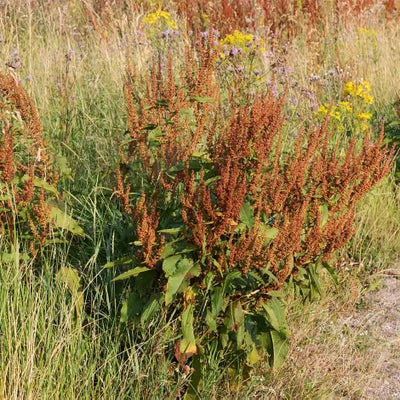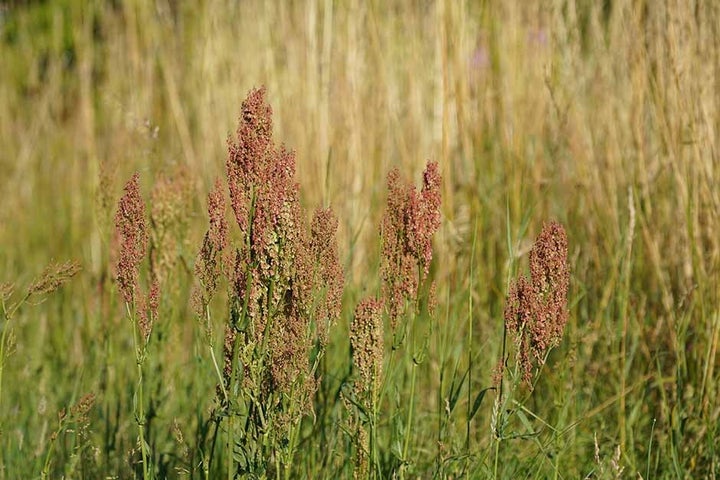
Quick facts
Broad-leaved dock’s botanical name is Rumex obtusifolius; it is also known as bitter dock, butter dock, kettle dock and cushy-cows
Curled dock’s botanical name is Rumex crispus; its other common names include curly dock and yellow dock
Broad-leaved dock and curled dock are both native to the UK and widespread
Docks provide food for many birds and insects, including moths and butterflies
If you need to control docks, non-chemical methods are effective
What do docks look like?
Broad-leaved dock and curled dock are two of the most widespread docks in the UK. Eighteen other species of Rumex commonly referred to as ‘dock’ are found growing in our countryside; some are UK natives, and some have been introduced. Hybridisation between species frequently occurs, so identification can be challenging. However, for control purposes, distinguishing between different species and hybrids isn’t essential, as they can all be controlled with the same methods.
The descriptions and images below will help you identify broad-leaved and curled docks. RHS members can use the RHS Gardening Advice service for help identifying other species.
Broad-leaved dock (R. obtusifolius) is a robust, long-lived . Its large, oval-shaped leaves have slightly wavy edges and grow to about 30cm (12in) long and 15cm (6in) wide. Low of new leaves appear in spring followed by upright flower stems throughout summer. Flower stems can reach a height of 1.2m (4ft) and have leaves along their length with flowers at the tips. Small pale green and red flowers in summer are followed by similar-coloured fruits which turn reddish-brown and can persist through the winter. Underground, branching taproots grow up to 1.2m (4ft) deep.

Curled dock (R. crispus) is similar in appearance to broad-leaved dock. The main differences are the leaf size and shape. The leaves of curled dock are likely to be slightly shorter and significantly narrower, often no more than 8cm (3in) wide. The leaf margins of curled dock are also wavier and more curled than those of broad-leaved dock.

Are broad-leaved and curled docks weeds?
These docks are UK wildflowers and valuable wildlife plants, providing food for many insects and birds. The Biological Records Centre lists over 80 insects that use broad-leaved dock as a food plant; these include the small copper butterfly, and garden tiger and clouded buff moths. Dock leaves are a main food source for the larvae of green dock beetles and the seeds are important winter food for birds such as dunnocks and house sparrows.
It is perfectly acceptable, and indeed very beneficial, to allow docks to grow in some parts of your garden. However, where docks compete with other plants for moisture, nutrients, space and light, you might choose to remove them or limit their spread.
Docks are useful plants, with a long history of medicinal use. Their leaves, roots and seeds have been used to treat a wide range of ailments and it is widely believed that rubbing a dock leaf on a nettle sting helps to ease the discomfort. They also make an attractive addition to meadows, with their reddish-brown seed heads providing interest well into the winter.
Despite their many benefits, broad-leaved and curled docks are both listed in the Weeds Act 1959, which exists to control the spread of plants considered problematic on agricultural land. Under the legislation, control measures to prevent broad-leaved and curled docks from spreading need to be taken if an order to do so is served to you by a government official.
Although their inclusion in the Weeds Act 1959 reflects how successful docks are at spreading, they are much easier to manage in a garden situation compared to large areas of agricultural land.

Can you eat dock leaves?
The fresh, young leaves of broad-leaved and curled docks are edible and have a bitter, lemony taste. Although foragers may have an abundant supply, the leaves contain oxalic acid, so only small quantities should be eaten. Eating dock leaves can aggravate some medical conditions, so check with your doctor before foraging if you are concerned.
Frequently asked questions about controlling docks
Here are our answers to your most common questions about dealing with docks:
How invasive are docks?
Docks spread easily by seed and individual plants can produce large numbers of seed that remain viable for many years. The seed is dispersed by wind, water and animals, and can be introduced into gardens or allotments in manure. The good news is that deadheading plants prevents self-seeding and limits spread.
often emerge in spring or early autumn. Young plants quickly develop a and can regenerate from sections of root, so may be spread unintentionally by gardeners roots or chopping them up when digging. However, sections of root deeper than about 12cm (5in) are much less likely to regrow.
Although they prefer fertile, cultivated ground and grassland, docks can grow in a wide range of soils and conditions, and once established, they can cope with heavy competition from other plants.
Do I need to get rid of docks?
In most gardens it is not necessary to completely eradicate docks. Allowing some to grow in a species-rich lawn, meadow or wildlife corner is a great way to boost the of your garden and gives you the chance to enjoy their attractive flowers.
It is, however, a good idea to control docks to stop them spreading to parts of your garden where they might smother and outcompete other plants.
In the unlikely event that you are served with an order under the Weeds Act 1959 to control broad-leaved and/or curled dock on your land, then you must comply with this.


What is the easiest way to kill docks?
If you have docks growing where they are not wanted, there are several ways to control them:
- – remove faded flowers in summer to prevent self-seeding.
- Hoe off seedlings – do this promptly, when plants are still very young, before they develop taproots. Hoe on a warm, dry or windy day when possible, so exposed roots dry out quickly and die.
- Dig or fork out plants – ideally do this when plants are still young and haven’t had time to develop a deep root system or set seed. Aim to remove the top 12-15 cm (5-6in) of the root system; sections of root deeper than this are unlikely to regenerate. With awkwardly positioned plants, initially remove as much root as you can and then remove regrowth when it appears – over time this will weaken the plant.
- Cut regularly – use a strimmer, brushcutter or mower for large areas. Cutting back new growth regularly will weaken and eventually kill docks. This is likely to take several years but is better for soil health as it limits disturbance.
- Smother seedlings – apply a mulch of organic matter, around 10cm (4in) thick, to your soil in early spring to smother emerging seedlings. Alternatively fill gaps in borders with ground cover plants.
- Smother plants – cover with a layer of compostable material, such as cardboard, and then a layer about 20cm (8in) thick of organic matter, such as or wood chips. Alternatively, use a heavy grade matting. This will block light and prevent growth, causing the root system to die. Keep soil covered for a few years, topping up the mulch layer if necessary, to ensure this method is effective. As dock seed can remain viable for many years, regularly check for and control emerging seedlings when the cover is removed.
- Avoid disturbing the soil – docks can regenerate from root fragments, so avoid digging over or rotavating the soil where they grow, as this will chop up and spread the roots.
Top Tip
Don’t add the seed or roots of docks to your home compost bin, as it may not reach high enough temperatures to kill them. Instead, put them in your council green waste recycling bin or take them to your local recycling site.
Should I use weedkiller?
As non-chemical control methods are effective, even if time-consuming, there is no need to use weedkillers.
For more information, see our page on non-chemical weed control.
The RHS does not support the use of weedkillers and recommends that alternative control methods are used. However, we do note that when gardeners struggle to control plants with cultural methods, regulated weedkillers/pesticides for home gardeners are available for use legally. Garden centres and large retailers selling weedkillers have trained staff who can advise on suitable products for your needs.
















